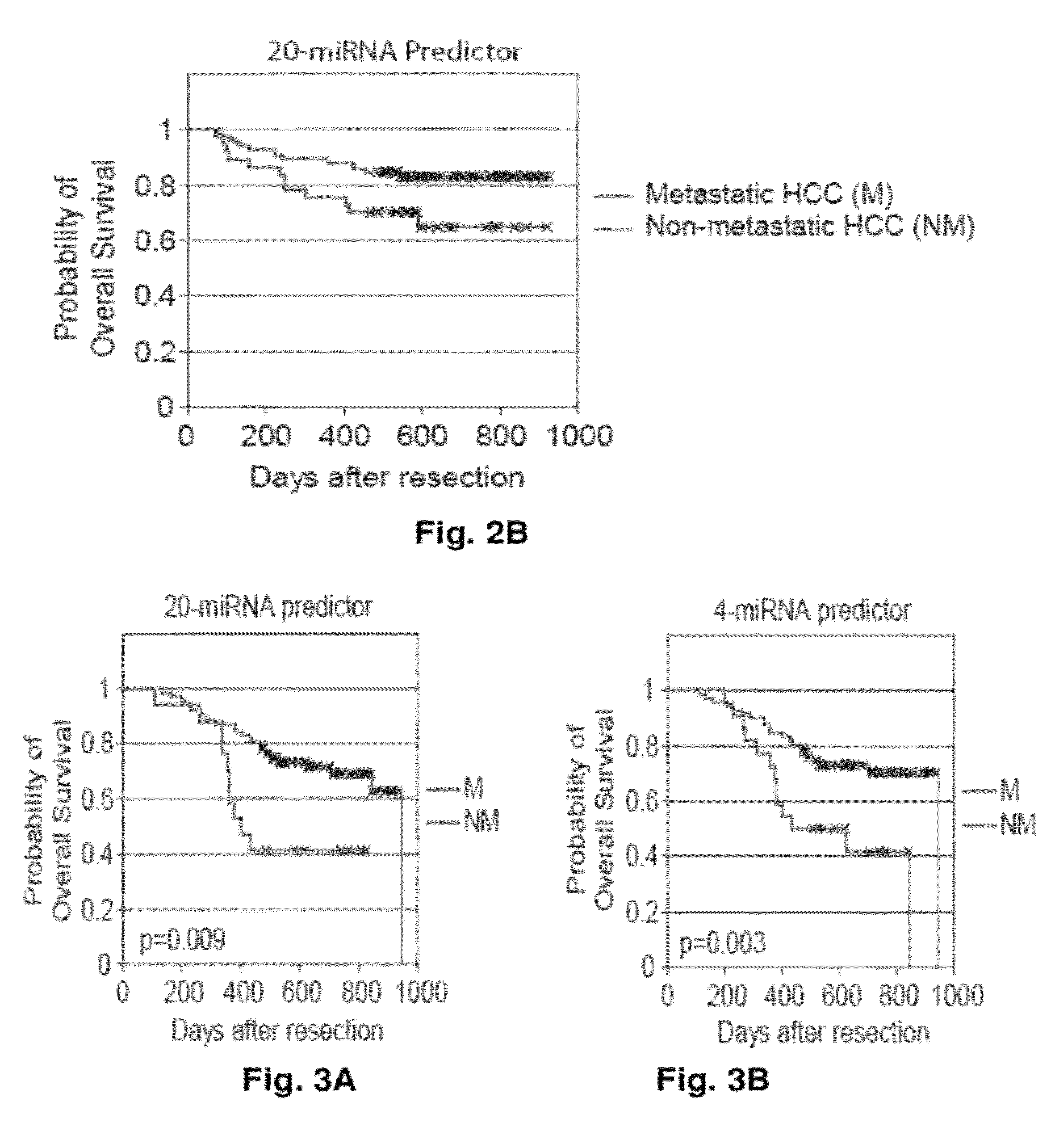MicroRNA expression signature for predicting survival and metastases in hepatocellular carcinoma
a technology of hepatocellular carcinoma and microrna, which is applied in the field of microrna expression signature for predicting survival and metastases in hepatocellular carcinoma, can solve the problems of high frequency of metastasis/recurrence in resected patients, affecting the prognosis of hcc patients, and only 30-40 percent of 5 year survival, etc., to achieve independent and significant predictor of patient prognosis and relaps
- Summary
- Abstract
- Description
- Claims
- Application Information
AI Technical Summary
Benefits of technology
Problems solved by technology
Method used
Image
Examples
example iii
[0103]In one particular aspect, there is provided herein a method of diagnosing whether a subject has, or is at risk for developing, hepatocellular carcinoma (HCC). The method generally includes measuring the level of at least one miR gene product in a test sample from the subject and determining whether an alteration in the level of the miR gene product in the test sample, relative to the level of a corresponding miR gene product in a control sample, is indicative of the subject either having, or being at risk for developing, HCC. In certain embodiments, the level of the at least one miR gene product is measured using Northern blot analysis. Also, in certain embodiments, the level of the at least one miR gene product in the test sample is less than the level of the corresponding miR gene product in the control sample, and / or the level of the at least one miR gene product in the test sample is greater than the level of the corresponding miR gene product in the control sample.
[0104]I...
example iv
Measuring miR Gene Products
[0105]The level of the at least one miR gene product can be measured by reverse transcribing RNA from a test sample obtained from the subject to provide a set of target oligodeoxynucleotides; hybridizing the target oligodeoxynucleotides to a microarray comprising miRNA-specific probe oligonucleotides to provide a hybridization profile for the test sample; and, comparing the test sample hybridization profile to a hybridization profile generated from a control sample. An alteration in the signal of at least one miRNA is indicative of the subject either having, or being at risk for developing, HCC.
example v
Diagnostic and Therapeutic Applications
[0106]In another aspect, there is provided herein are methods of treating HCC in a subject, where the signal of at least one miRNA, relative to the signal generated from the control sample, is de-regulated (e.g., down-regulated and / or up-regulated).
[0107]In certain embodiments, the miR gene product comprises one or more of the SEQ ID NOS: 1-22, as shown in FIG. 11. In particular certain embodiments, one miR gene product comprises one or more of: miR-219 [SEQ ID NO: 20], miR-207 [SEQ ID NO: 18], miR-30c [SEQ ID NO: 6], and miR124A [SEQ ID NO: 4] and combinations thereof.
[0108]Also provided herein are methods of diagnosing whether a subject has, or is at risk for developing, a HCC associated with one or more adverse prognostic markers in a subject, by reverse transcribing RNA from a test sample obtained from the subject to provide a set of target oligodeoxynucleotides; hybridizing the target oligodeoxynucleotides to a microarray comprising miRNA-...
PUM
| Property | Measurement | Unit |
|---|---|---|
| stress response | aaaaa | aaaaa |
| Northern blot analysis | aaaaa | aaaaa |
| color | aaaaa | aaaaa |
Abstract
Description
Claims
Application Information
 Login to View More
Login to View More - R&D
- Intellectual Property
- Life Sciences
- Materials
- Tech Scout
- Unparalleled Data Quality
- Higher Quality Content
- 60% Fewer Hallucinations
Browse by: Latest US Patents, China's latest patents, Technical Efficacy Thesaurus, Application Domain, Technology Topic, Popular Technical Reports.
© 2025 PatSnap. All rights reserved.Legal|Privacy policy|Modern Slavery Act Transparency Statement|Sitemap|About US| Contact US: help@patsnap.com



